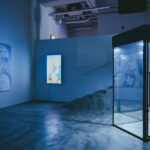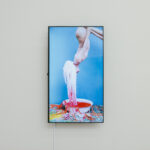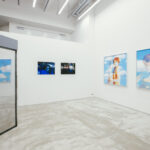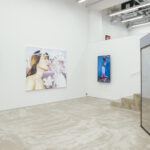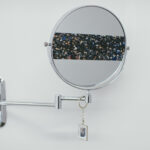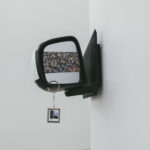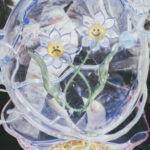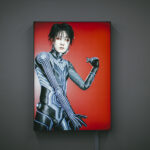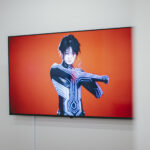Exhibition
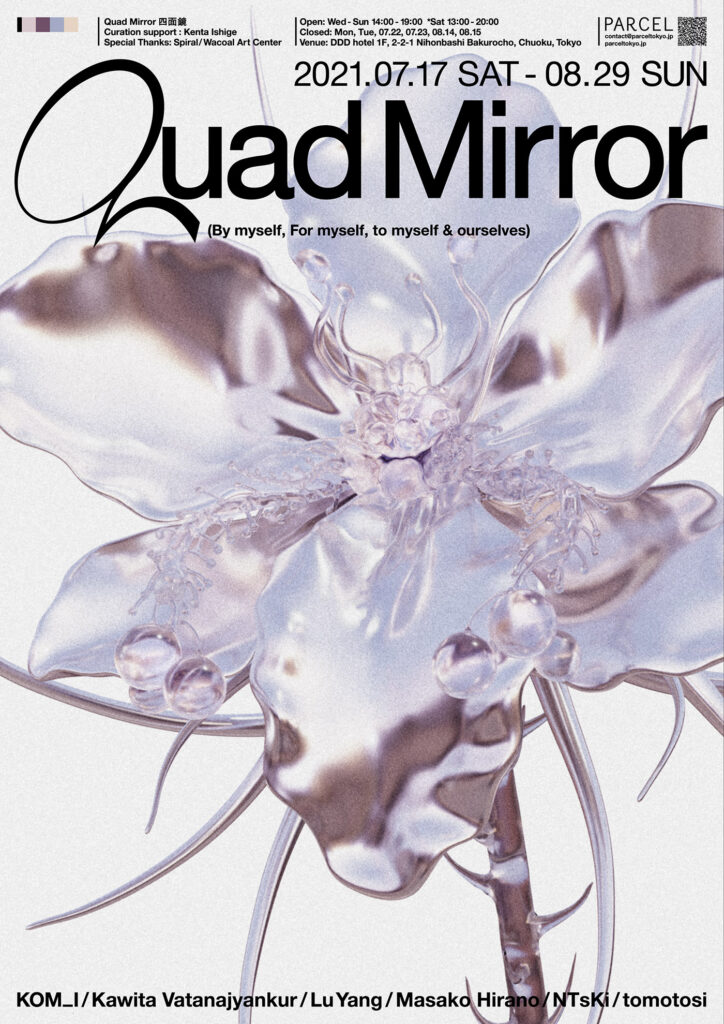
Past Exhibition
2021
07.17Sat
08.29Sun
at PARCEL
Open on Wed - Sun
14:00-19:00
/ Sat 13:00 - 20:00
Closed on Mon / Tue / 7.22,23 / 8.14,15
reception :
07.16.Fri. 18:00-21:00
4面鏡 / Quad Mirror (By myself, For myself, to myself & ourselves)
KOM_I / Kawita Vatanajyankur / Lu Yang / Masako Hirano / NTsKi / tomotosi
details - JP
私たちは、InstagramなどのSNSを通じて、日々 数々の自撮り(selfie)を目にしています。selfie がネット上に出現し始めた当初、それらは多くの人にとって自己顕示やナルシズムなど儚い自己表現と結びついたイメージを持つものとして受け取られていました。今日では、インスタグラマーをはじめとしたあらゆる表現者達は、自分自身のselfieをより戦略的に利用し、個人と社会の関係性を作り出す道具/手段として利用しています。いつ、誰と、どこで、どのような状況で自分自身を撮影しているのか。フォロワー達もその画像の持つ些細な情報にメッセージ性を読み、自らの価値観に反映させています。また、かつてのセルフポートレート(肖像写真)は美術館やギャラリーなどの特別な空間に置かれているものでしたが、現代においては、あらゆる小さな集団(トライブ)の世界観を繋ぎ、その小さな集団がどこに向かっていくのか、その指針を示す表現としての役割を新たに持つようになったとも言えます。
本展に参加する6名の作家は、様々な国籍・バックグラウンドを持ち、自らのセルフポートレートを戦略的に、社会との接点/小さいな集団の意思疎通の為のツールとして利用しています。セルフポートレートという共通項を持ちながらも、写真・インスタレーション・3DCGアニメーションなどの彼らの多様な作品を通して、かつてのアートにおけるセルフポートレートとは異なる目的と用途を持った、SNS時代のポートレート・アートの再定義を試みる展示会となります。
4面鏡/Quad Mirror(By myself, For myself, to myself & ourselves)についての覚書
1. インフラ
朝起きてこのテキストを目にするまでにスマートフォンに触れなかった人はいるだろうか?インターネットに接続しなかった人は?SNSを開かなかった人は?
改まって言葉にするまでもなく現代の中でスマートフォンもインターネットもSNSも我々の生活を構成するインフラ、あるいはライフラインと化している。もはやこういった発明品たちが存在しなかった時代のことなど思い出すこともなく、我々はこれらの発明品に寄り添い、共存し、発明以前以後では明確に異なった社会を生きている。
2. 鏡
振り返ってみれば我々は歴史の中で様々なものを発明し、自らの生活や社会を変容させてきた。火や車輪といった原始的なものに始まり、蒸気機関や半導体など枚挙に暇がないが、こと芸術や文化において何が重要な発明であったかを考えるに鏡の発明は特筆すべきものだろう。現在も用いられているガラス鏡に近い錫アマルガムを反射材料に用いたガラス鏡は14-15世紀頃にヴェネチアで発明された。この発明がルネサンス以降の絵画に「自画像」というジャンルを生み出し、やがて、「自己」や「内省」を発達させ、自己の内面を語る小説という文学の誕生を促し、それが個人の人権意識の確立にもつながっていった(*1)。自分の顔を映す発明品が世界も自分自身をも変容させたのだ。
3. フロントカメラとSNS
鏡の発明によって自画像が発生したように、後年、カメラが発明されたのちに写真領域でも自写像というものが誕生する。感光剤を用いて媒体に映り込んだ景色を定着させる機器としてのカメラが発明されたのは19世紀前半であるが、この手法が単なる作家自身の風貌の記録ではなくある種の表現として使われるようになったのは1960年代とやや間が空いている(初期の表現としての自写像がフェミニズム・ムーヴメントやカウンター・カルチャーの表象であったことは、先ほど触れた鏡の発明による個人の人権意識確立の延長線上にあるかもしれない(*2))。さらに現代、携帯電話機の画面側に搭載されたフロントカメラによって、セルフポートレートはその大元にある鏡としての機能を再度手に入れることとなる。画面を見つめる自分をほぼ目線と同じ角度から見つめ返すことができるようになったことで、ほぼ鏡像に近いイメージがそこには映し出されるようになり、そうして現在我々が目にするような「selfie」は誕生した。
4. 分裂
ロラン・バルトは『明るい部屋』にて、肖像写真をめぐる経験を「4人の私」と表現した。すなわち「私が自分はそうであると思っている人間、私が人からそうであると思われたい人間、写真家が私はそうであると思っている人間、写真家がその技量を示すために利用する人間」である(3)。selfieにおいてもこの分裂は可能であろうか。おそらくロランバルトの提示した分裂はほとんど全て一人の行為へと還元されていく。しかしselfieはそのような閉じた自己言及の中で行われるものではなく、社会網へと放出されていくことまでその経験の中に含まれている。鏡の向こう側から無数の視線に晒されることが前提なのだ。「ソーシャルメディア集団(tribe)が美的な選択と経験を通じて自分たちを維持していく場(4)」というのがマノヴィッチの唱える「美的社会」だ。投稿数の分析などから、SNSユーザーたちがselfieを投稿することで構築される社会はすでに存在していることも明らかだ。そこで発生するselfieをめぐる経験を今回の副題であるBy myself, For myself, to myself & ourselvesと名付けている。
セルフポートレートには現在、シンディ・シャーマンから連なるアマリア・ウルマンのような自己像を社会の中で批評的に用いる伝統も当然引き継がれている。しかし、それらとは別の方向性として新たに誕生した、ハッシュタグをつけられ、AIに画像を判断され、個人と社会とをつなぐインターフェースとなり、タイムラインに流されていくセルフポートレートであるselfieと呼ばれる一連の行為、あるいは運動体について『4面鏡/Quad Mirror』は考える機会となりたい。
*1 世界をつくった6つの革命の物語/スティーブン・ジョンソン
*2 私という未知へ向かって 現代女性セルフポートレート展
*3 明るい部屋-写真についての覚書/ロラン・バルト
*4 インスタグラムと現代視覚文化論/レフ・マノヴィッチ
Text by 石毛 健太
details - EN
Through various social networking services such as Instagram, we are constantly exposed to numerous selfies. When the selfie first appeared on the Internet, it was perceived by many as an image associated with narcissism, and other forms of evanescent self-expression. Today, Instagrammers and other artists of all kinds are using their own selfie more strategically as a tool/means to generate personal and social relationships. The question is: when, with whom, where, and under what circumstances are you photographing yourself? Their followers also decode the messages in the images and reflect them in their own sense of values.
In the past, self-portraits were reserved for special spaces such as museums and galleries. However, in the present day, these have taken on a new role as an expression that connects the perspectives of all small groups (tribes) and points out where these communities are heading.
The six artists participating in this exhibition come from a variety of nationalities and backgrounds, but they all share a common interest in using themselves as a strategic tool for social interaction / communication. The exhibition will explore the redefinition of self-portraits in the age of social networking services (SNS) , from the conventional art of self-portraiture, through the diverse works of the artists, including photographs, videos, 3DCG animations, and an installation.
Notes on 4面鏡/ Quad Mirror(By myself, For myself, to myself & ourselves
1. Infrastructure
Who hasn’t touched their smartphone before seeing this text today? Who hasn’t connected to the Internet or opened a social networking site? In this era, smartphones, the Internet, and social networking sites have become the infrastructure, or lifeline, of our daily lives. We can no longer recollect a time when these inventions were nonexistent, and we are now living in a society that is distinctly different from the one before and after these inventions, in which we currently cohabitate with.
2. Mirror
In retrospect, we have invented many things throughout history that have transformed our lives and society. Starting from primitive things like fire and the wheel, to the steam engine and semiconductors, there is no end to this list. However, the invention of the mirror is worth noting when we consider its importance in art and culture. The glass mirror that uses tin amalgam as a reflective material, which is similar to the glass mirror used today, was invented in Venice around the 14th to 15th century. This invention gave birth to the genre of “self-portrait” in post-Renaissance paintings, which eventually led to the development of the idea of “self” and “self-reflection” leading to the birth of a literature form, the novel, telling the story of one’s inner life, which further led to the establishment of the consciousness of individual human rights (*1). The invention of reflecting one’s own face has transformed not only the world but also oneself.
3. Front Camera and SNS
Just as the invention of the mirror gave birth to the self-portrait, the invention of the camera later gave birth to the self-portrait in the field of photography. It was in the early nineteenth century that the camera was invented as a device using a photosensitive compound to fix the reflected image on a medium, but it was not until the 1960s that this tool came to be used as a kind of artistic expression rather than simply recording the artist’s appearance. (The fact that the self-portrait as an early expression was a representation of the feminist movement and counter-culture may be an extension of the establishment of individual human rights awareness with the invention of the mirror, as mentioned earlier (*2)). Furthermore, in the modern age, with the addition of front cameras mounted on the screens of cell phones, self-portraiture has regained its original function as a mirror. By being able to look back at oneself staring at the screen from almost the same angle as one’s eyes, an image that is almost a mirror image can be projected, and thus the “selfie” as we see it today was born.
4. Division
In “LA CHAMBRE CLAIRE”, Roland Barthes described the experience of portrait photography as “four I’s”. That is, “the person I think I am, the person I want people to think I am, the person the photographer thinks I am, and the person the photographer uses to demonstrate his skills” (3). Is this division possible in the selfie? Perhaps the division presented by Roland Barthes can be reduced almost entirely to the act of one person. However, the selfie does not take place in such a closed self-reference, but is included in the experience of being released into the social network. It is a precondition for being exposed to countless eyes from the other side of the mirror. Manovich’s “aesthetic society” is a place where “social media groups (tribes) maintain themselves through aesthetic choices and experiences (4)”. From the analysis of the number of postings, it is clear that a society that is formed by SNS users posting selfies is already in existence. The experiences surrounding the selfie that occur in this society are the subtitle of this project, “By myself, For myself, to myself & ourselves”.
In self-portraiture, there is a tradition of critical use of self-portraits in society, such as that of Amalia Ullman, continuing from Cindy Sherman. However, “Quad Mirror” gives us the opportunity to think about a series of actions or movements called the “selfie”, which is a self-portrait that has been newly born as a different direction from those, and which is hashtagged, judged by AI, becoming an interface between the individual and society, and being circulated on our timelines.
*1 How We Got To Now /Steven Johnson
*2 Self Portraits of Contemporary Women, Exploring the Unknown Self / Tokyo Metropolitan Museum of Photography
*3 LA CHAMBRE CLAIRE / Roland Barthes
*4 Instagram and Contemporary Image / Lev Manovich
Text by Kenta Ishige
Curation Support:石毛 健太 / Kenta Ishige
Special Thanks:Spiral / Wacoal Art Center
ARTISTS BIO [Eng follows]
Kawita Vatanajyankur / カウィタ・ヴァタナジャンクール
カウィタは現代社会における女性の身体と、環境や社会との関係を題材にパフォーマンス・ヴィデオ作品を制作するアーティストです。カウィタのパフォーマンスは一見ユーモラスでありながらも、女性の性差別、職業差別、また暴力などの問題を象徴しています。主な個展に「UNVEIL ESCAPE」(Gallery Seescape, Thailand, 2019年)、「FOUL PLAY」(Albright Knox Art Gallery, USA, 2019年)などがあり、グループ展に2017年には、イタリアのヴェネツィアで開催された「Islands in the Stream」展、メルボルン・アーツセンターで開催された「Asia Triennale of Performing Arts」展などがある。
www.kawitav.com IG : @kawitavv
コムアイ / KOM_I
水曜日のカンパネラやYAKUSHIMA TREASUREのヴォーカルとして活動する傍ら、ライブの空間設計からパフォーマンスまで音楽に関わる多様な表現領域を開拓。またファッションやアート、社会問題など幅広い領域に介入するカルチュラルアクティビスト。近年はオオルタイチと共に屋久島や熊野など、国内の地域へのリサーチをベースとした楽曲作品を制作している。インド古典音楽や能楽、アイヌのウポポやバリ舞踊など、伝統的な芸能に大きな影響を受けている。主な活動に2021年「YAKUSHIMA TREASURE ANOTHER LIVE from YAKUSHIMA」、2019年「YAKUSHIMA TREASURE LIVE at LIQUIDROOM」など。
another.yakushimatreasure.com IG : @kom_i_jp
Lu Yang / ルー・ヤン
中国生まれ。中国芸術院を卒業し、現在は上海を拠点に活動。科学、生物学、宗教、大衆文化、サブカルチャー、音楽など、さまざまなテーマを主題とし、映像やインスタレーション、デジタルペイントを組み合わせた作品を制作。主な個展に「Electromagnetic Brainology」(sprial、東京、2018 年)、「LU YANG Screening Program」(アーツ千代田 3331、東京、2013 年)。グループ展に「ヴェネツィア・ビエンナーレ」(2015 年)、「A Shaded View on Fashion Film」(ポンピドゥーセンター、パリ、2013 年)などがある。
luyang.asia IG : @luyangasia / @doku.asia
平野 正子 / Masako Hirano
2019年よりベルリン・東京の2拠点で活動。近年は3DCGを用いた作品を制作し、CGIと自身のポートレートを組み合わせポップかつキッチュな作品を生み出している。平野の表現が映す世界は非常にフラットかつクリアで、しかしカオスや矛盾に満ちている。あらゆる視覚情報がデータ化され高速で消費されて SNS の時代に、自身の表現(自分自身のポートレートでさえ)が情報に流されることを受け入れながらも、時代の脳裏に焼きつくイメージを模索している。アートディレクター/グラフィックデザイナーとしてReebokやラフォーレ原宿などの企業や商業施設のキャンペーン広告、水曜日のカンパネラ、Tohjiなどのミュージシャンへのビジュアル提供といったコミッションワークなどを手掛け、ジャンルを超えた活動を展開している。
masakohirano.com IG : @cokepoteto
NTsKi / エヌ・ティー・エス・ケー・アイ
NTsKiは音楽・写真・映像を通じて、場所や時代を超えた記憶や気配を具現化するアーティスト。主な活動はミュージシャンとして知られているが、楽曲やMV、ビジュアルやパフォーマンスも全て作品としてプロデュースし、配信や流通までも自身で管理している。これらの総合的な創作活動をアートとして捉えており、音楽とアートのメディアを横断した共感覚を切り開くアーティストである。主な活動に2021年Giant Clawのアルバム「Mirror Guide」にヴォーカルとして参加、2020年「大京都芸術祭」(京丹後市)などがある。2021年8月6日、デビュー・アルバム『Orca』を米オハイオのレーベル〈Orange Milk〉/〈EM Records〉よりリリースする。
トモトシ / tomotosi
1983年山口県生まれ、東京都拠点。豊橋技術科学大学建設工学課程を卒業後10年にわたって建築設計・都市計画に携わる。2014年より映像インスタレーション作品を発表。都市空間や公共ルールに歪みを生むアクションを行う。2020年より西荻窪にトモ都市美術館(現TOMO都市美術館)を企画運営。主な展覧会に「ヘルニア都市」(トモ都市美術館 2020)、「有酸素ナンパ」(埼玉県立近代美術館 2019年)、「あいちトリエンナーレ2019」(豊田市 2019年) などがある。
tomotosi.com IG : @tomotossi
Kawita Vatanajankur
Kawita Vatanajankur is an artist who creates performance video works about the female body in contemporary society and its relationship to the environment and society. Her performances are humorous at first glance, yet symbolic of issues such as sexism, occupational discrimination, and violence against women. Her solo exhibitions include “UNVEIL ESCAPE” (Gallery Seescape, Thailand, 2019) and “FOUL PLAY” (Albright Knox Art Gallery , USA, 2019), and group exhibitions include “Islands in the Stream” in Venice, Italy in 2017, and “Asia Triennale of Performing Arts” at Melbourne Arts Center.
www.kawitav.com IG : @kawitavv
KOM_I
While active as the vocalist of Wednesday’s Campanella and YAKUSHIMA TREASURE, Kom-i has pioneered various areas of expression related to music, from designing live stages to her actual musical performances. She is also a cultural activist who intervenes in a broad range of fields from fashion and art to social issues. Recently, she has been creating musical compositions based on her research into regional areas such as Yakushima, and folk performing arts such as Indian and Balinese dance and Noh theater. Her major activities include “YAKUSHIMA TREASURE ANOTHER LIVE from YAKUSHIMA” in 2021 and “YAKUSHIMA TREASURE LIVE at LIQUIDROOM” in 2019.
another.yakushimatreasure.com IG : @kom_i_jp
Lu Yang
Born in China, Lu Yang graduated from the Chinese Academy of Arts and currently lives and works in Shanghai. His works include videos, installations, and digital paintings based on various themes such as science, biology, religion, popular culture, subculture, and music. Solo exhibitions include “Electromagnetic Brainology” (sprial, Tokyo, 2018) and “LU YANG Screening Program” (3331 Arts Chiyoda, Tokyo, 2013). Group exhibitions include “Venice Biennale” (2015) and “A Shaded View on Fashion Film” (Centre Pompidou, Paris, 2013).
luyang.asia IG : @luyangasia / @doku.asia
Masako Hirano
Based in both Berlin and in Tokyo from 2019, Hirano is known for her recent kitche and pop 3DCG works combined with self-portrait. The images she creates are flat and clear, yet full of chaos and contradictions. In the age of SNS, where all visual information is converted into data and consumed at a high speed, Hirano accepts the fact that her own expression (or even her own portraits) are being swept away by information, while seeking images that will burn into the minds of the present generation. Hirano is also known for the art direction / graphic design works for corporates such as Reebok, and Laforet Harajuku, while creating commissioned art works for musicians such as Wednesdays Campanella(JPN) and Tohji (JPN) transcending genres, active in a broad field.
masakohirano.com IG : @cokepoteto
NTski
NTsKi is an artist who transforms memories and signs that transcend place and time into her works through music, photography, and video. Although she is primarily known as a musician, NTsKi also produces all of her music, music videos, graphic visuals, and performances as her work of art, and even controls its distribution and circulation by herself. She considers these comprehensive creative activities as art, and is an artist who opens up synesthesia transcending the media of music and contemporary art. Her main activities include participating as a vocalist in Giant Claw’s album “Mirror Guide” in 2021, and participating in the “Grand Kyoto Art Festival” (Kyotango City) in 2020. On August 6th, 2021, her debut album “Orca” will be released via Orange Milk / EM Records (OH, USA).
tomotosi
Born in Yamaguchi Prefecture in 1983, currently based in Tokyo. After graduating from Toyohashi University of Technology with a degree in construction engineering, he worked in architecture and urban planning for a decade. Since 2020, he has been organizing and managing the Tomo Tosi(urban in Japanese) Art Museum in Nishiogikubo, Tokyo. His major exhibitions include “Hernia City” (Tomo Tosi Art Museum 2020), “Aerobic Nampa” (The Museum of Modern Art, Saitama 2019), and “Aichi Triennale 2019” (Toyota City 2019).
tomotosi.com IG : @tomotossi

